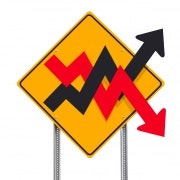Bright, beautiful and contrary
PORTFOLIO POINT: It might be attractive, but gold is difficult to understand: it’s the youngest asset class, a risky safe haven and volatile.
I'm not sure I understand gold. I don't know how high its price may go or when it may turn. I'm not sure I know what makes it tick. With that disclaimer, here are a few comments:
First, it's not clear what valuation metric to use if you treat gold as an asset, rather than a commodity. There are some quirky metrics around, as there are in every cycle. The technology bubble had price/sales (a metric that ignores earnings – useful for valuing companies that don't have any). The debt-fuelled boom that's now busting had EV/EBITDA (a metric that cunningly ignores debt – useful for valuing over-levered and negative cash flow assets).
Gold? There's no one accepted metric. Quite a few seem to focus on ratios to other assets: gold/Dow Jones, for example. Exhibit 1 shows gold relative to the S&P 500. If this mean-reverts, there would be a great trade (sell stocks, buy gold – it's not clear which direction the two components move). Will the ratio mean-revert? I don't know.

Part of the problem analysing gold is that it's the youngest asset class (a point made by Shayne Maguire in Buy Gold Now). It has been trading freely only since 1971; from 1933-71 its price was pegged; and prior to 1933 gold was money. (This is why, as an aside, I don't think there's a natural tendency for, say, the gold/stock index ratio to mean-revert to its long-term average because for much of the long-term history that ratio was simply the price of stocks denominated in gold “currency”.)
Second, the most common rationale for gold is inflation risk (or, more dramatically, the debauchment of fiat money). This is clearly just a forecast. We are now in the midst of a glorious period for fiat currency. The folding stuff you've got in your pocket now buys a lot more petrol than it did a couple of years ago, a lot more copper, a lot more Florida condo, and a lot more S&P 500. The only thing it doesn't buy more of is gold.
This means buying gold for inflation risk is a remarkably far-sighted trade. Moreover, it runs against other market-based inflation indicators that are sending the reverse signal, such as Treasury breakeven inflation rates (Exhibit 2).

However, history does suggest that there's one thing better for gold than inflation: deflation. For an investor community bewildered by last year's unexpected twists, this makes gold an attractive option: hedge against two tails in one trade. Exhibit 3 shows a long-term view on gold and US inflation (a 10-year average). While gold (famously) did well in the 1980s, it wasn't such a good hedge against the rising inflation trends of the early 1900s or the 1950s. But it did work very well in the 1930s.

It is worth noting that the behaviour of gold in deflation confirms that it should be treated as an asset, not a commodity. In inflation, most tangible assets are preferable to paper assets. In deflation that's not true. As Exhibit 4 shows, the copper price collapsed in the 1930s, while gold soared; the same has happened in the current cycle.
This suggests that the biggest threat to gold is not that policy makers fail to reflate the global economy, but that they succeed. Failure, and the consequent deflation, would be particularly beneficial for gold. Success – even if that increased the down-the-track risk of inflation – would be supportive for most hard assets, but not gold particularly.

Third, if risk assets do well, safe havens don't. But gold is not your typical safe haven. In my view, the most dangerous risk of holding a safe-haven asset should be the opportunity cost: the risk of not participating in upside. This is the quid pro quo for avoiding downside. In this context, gold is an investment oxymoron: a risky safe haven. It carries not just opportunity cost, but the prospect of outright declines if risk appetites revive.

Finally, it's worth noting that gold is not only a new asset class, but it's also very small. Exhibit 5 shows approximate asset sizes (I have excluded official reserve holdings from the gold number, as well as an estimate for gold that has been used for industrial purposes). Gold is volatile because it's a small asset class (with a tight free-float). A relatively small asset allocation shift from, say, Treasuries to gold, would have a barely discernible impact on the Treasury market, but would push gold significantly higher.
I don't think I'm the only person who doesn't “understand gold”. Its strength attracts attention, and attracts flows. If those flows continue, then the price could, in a sense, go anywhere. If it became even a small part of the “standard” asset allocation, the price gains could be very large, and arguably, sustained. But if gold is now just a fear-with-momentum trade, the global macro recovery – whenever that comes – could produce a major setback.
![]() Gerard Minack is chief market strategist of Morgan Stanley Australia.
Gerard Minack is chief market strategist of Morgan Stanley Australia.
















